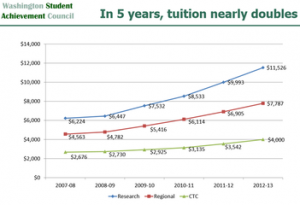 You may have heard stories from your grandparents about how they used to walk 15 miles in the snow—uphill both ways—to get to school. (Eileen remembers these long treks herself!) These days, that’s easier than overcoming the barriers to a solid education for the youngest generation of high school graduates. In a 21st century economy having a college degree is more important than ever, but getting one can take a lot longer than four years and result in crippling debt and an unhealthy lifestyle due to stress and lack of support services.
You may have heard stories from your grandparents about how they used to walk 15 miles in the snow—uphill both ways—to get to school. (Eileen remembers these long treks herself!) These days, that’s easier than overcoming the barriers to a solid education for the youngest generation of high school graduates. In a 21st century economy having a college degree is more important than ever, but getting one can take a lot longer than four years and result in crippling debt and an unhealthy lifestyle due to stress and lack of support services.
Here are 6 challenges college students face today:
 1. Rising Tuition. College students throughout the state worry about annual increases in tuition, which has risen substantially since the 2008 recession. The trend of rapidly-increasing tuition and corresponding rise in debt loads is becoming a barrier to obtaining a college degree for many students. This has employers looking to hire skilled workers in our state very concerned. Last year the legislature froze tuition at state universities but in order to keep tuition affordable and fully fund colleges and universities, we need to find a permanent funding solution.
1. Rising Tuition. College students throughout the state worry about annual increases in tuition, which has risen substantially since the 2008 recession. The trend of rapidly-increasing tuition and corresponding rise in debt loads is becoming a barrier to obtaining a college degree for many students. This has employers looking to hire skilled workers in our state very concerned. Last year the legislature froze tuition at state universities but in order to keep tuition affordable and fully fund colleges and universities, we need to find a permanent funding solution.
2. Hefty loans. More than half of Washington’s college students take on debt to pay for their degree. Private loans often come with high monthly interest rates that students must pay even while they’re in school. The average student debt in Washington state is $24,418 according to The Project on Student Debt. States across the country are considering a Pay-It-Forward system that would give students the option to attend college tuition-free and instead contribute a small percentage of their income after they graduate. This year the legislature is considering a bill to implement this system for students pursuing a nursing degree.
 3. Pricey Textbooks. The average student spends around $1,200 a year on textbooks and prices are on the rise. This means students sometimes have to give up taking the course they’re interested in if the assigned textbook is too expensive. This year several bills have been proposed to reduce colleges’ reliance on pricey textbooks.
3. Pricey Textbooks. The average student spends around $1,200 a year on textbooks and prices are on the rise. This means students sometimes have to give up taking the course they’re interested in if the assigned textbook is too expensive. This year several bills have been proposed to reduce colleges’ reliance on pricey textbooks.
4. Obtaining and Keeping Financial Aid. Right now Washington’s State Need Grant only serves two-thirds of the students who are eligible to receive it. That means 33,000 students rely on other programs to help with college costs. Some of those sources are tied to a student maintaining a full-time course load, which isn’t always financially feasible.
5. Balancing Work and School. Last week Eileen met with a student who works two jobs on top of attending school full time just so she could cover rent, food and textbooks. Handling bills, a job and a full course load can be stressful for anyone, especially a young adult—and it doesn’t always cover all of a student’s expenses.
6. Mental Health. Suicide is the third leading cause of death among college students. The stresses of working to pay for school combined with living alone for the first time make this an especially difficult time in a young person’s life. This year the House is considering providing more targeted support for college students facing mental health problems.
 Those of us who were fortunate enough to go to college look back on those four years as one of the best times of our lives. It was a chance to explore new ideas, discover new passions and ultimately prepare for a career that would help us to support our families. We need to make sure that experience isn’t denied to younger generations due to overwhelming cost.
Those of us who were fortunate enough to go to college look back on those four years as one of the best times of our lives. It was a chance to explore new ideas, discover new passions and ultimately prepare for a career that would help us to support our families. We need to make sure that experience isn’t denied to younger generations due to overwhelming cost.
Thanks for staying up-to-date on the issues in Olympia. Please don’t hesitate to get in touch!

